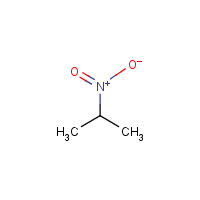2-Nitropropane
Agent Name
2-Nitropropane
CAS Number
79-46-9
Formula
C3-H7-N-O2
Major Category
Nitrogen Compounds

Synonyms
2-NP; 2-Nitropropane; Dimethylnitromethane; Isonitropropane; Nipar S-20; Nipar S-20 solvent; Nipar S-30 solvent; Nitroisopropane; beta-Nitropropane; [ChemIDplus] UN2608
Category
Nitros, Aliphatic
Description
Colorless liquid with a pleasant, fruity odor; [NIOSH]
Sources/Uses
Used as additive to solvents in concentrations from 5% to 25% to improve drying or flowing characteristics; these solvents are used for coatings, chlorinated rubbers, inks, and adhesives; [ACGIH] "Occupational exposure to 2-NP may occur in many industries including industrial construction and maintenance, printing (rotogravure and flexographic inks), highway maintenance (traffic markings), shipbuilding and maintenance (marine coatings), furniture, and plastic products." [http:www.cdc.gov/niosh/80-142.html]
Comments
Acute liver injury and/or death have been reported in workers 1) painting the interior of a tank, 2) working in confined spaces with paint and polyester-based resin products, and 3) painting epoxy resins on walls. NP-2 induces methemoglobinemia of 15-25% in cats exposed at 280 ppm for 7 hours. Listed in the table "Examples of Industrial Chemicals for Which Methemoglobin Formation is NOT the Principal Cause of Toxicity"; [ACGIH] A skin, eye, and respiratory tract irritant; Inhalation of high concentrations may cause CNS effects; Exposure above the OEL could cause liver injury and death; [ICSC]
Reference Link #1
Biomedical References
Exposure Assessment
Skin Designation (ACGIH)
Insufficient data
TLV (ACGIH)
10 ppm
PEL (OSHA)
25 ppm
IDLH (NIOSH)
100 ppm
Excerpts from Documentation for IDLHs
Nausea, vomiting, diarrhea, anorexia, and severe headache have been reported in workers exposed to daily concentrations of 20 to 45 ppm [Skinner 1947].
Vapor Pressure
17.2 mm Hg
Odor Threshold Low
81 ppm
Odor Threshold High
288 ppm
Lethal Concentration
LC50 (rat) = 400 ppm/6H
Explanatory Notes
Odor threshold from AIHA; Flash point = 75 deg F; VP from HSDB;
NFPA
may ignite at ambient temp
Adverse Effects
Methemoglobinemia
MetHgb is secondary toxic effect
Neurotoxin
Other CNS neurotoxin
Hepatotoxin
Occupational hepatotoxin (principal effect)
IARC Carcinogen
Possible (2b)
NTP Carcinogen
Anticipated human carcinogen
ACGIH Carcinogen
Confirmed Animal
Diseases, Processes, and Activities Linked to This Agent
Diseases
Occupational diseases associated with exposure to this agent:
Processes
Industrial Processes with risk of exposure:
Activities
Activities with risk of exposure: